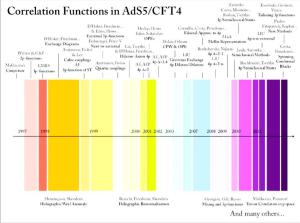The quest for an objective physical theory that reduces in some limit to quantum mechanics is a valid and important line of inquiry, but usually it is carried out without much attention to the mathematically most advanced quantum theories. Here I’m going to mention a few ideas for how N=4 Yang-Mills might emerge from a “realist” or “objective” ontology.
1) Gerard ‘t Hooft’s cellular automata. In a previous post, I mentioned ‘t Hooft’s mapping between a particular cellular automaton and a theory of free bosonic fields in 1+1 dimensions. In a subsequent paper, he extended the mapping to fermions as well, and explicitly noted that there might be some relationship to a superstring worldsheet theory. There are limitations to the utility of what ‘t Hooft has done, but the general ideas here are definitely of interest.
2) Bohmian mechanics for the CFT. N=4 Yang-Mills contains quantum fields of spin 0, 1/2, and 1. A Bohmian mechanics for spin-0 fields was worked out long ago, Peter Holland extended it to spin-1/2 fields, and now Tatiana Seletskaia points out that he claims to have done it for spin-1 fields too. I can’t endorse Holland’s work yet, but if a Bohmian formulation of the N=4 theory exists, that seems to imply that the AdS string theory would have to be implicit in it, too; which would be remarkable.
3) Hamilton-Jacobi theory in the bulk. “On the Holographic Renormalization Group”, an early and important AdS/CFT paper, tries to analyze the duality using Hamilton-Jacobi theory on the bulk side. This is another potential connection to Bohmian mechanics, which can be described as a deformation of classical Hamilton-Jacobi theory.
4. The twistor revolution. At the end of 2012, Arkani-Hamed et al finally came out with another major installment of their series on the Grassmannian representation of the N=4 theory. This paper is not about ontology, but it is a comprehensive rewrite of the math which will surely have ontological implications.

Recent Comments